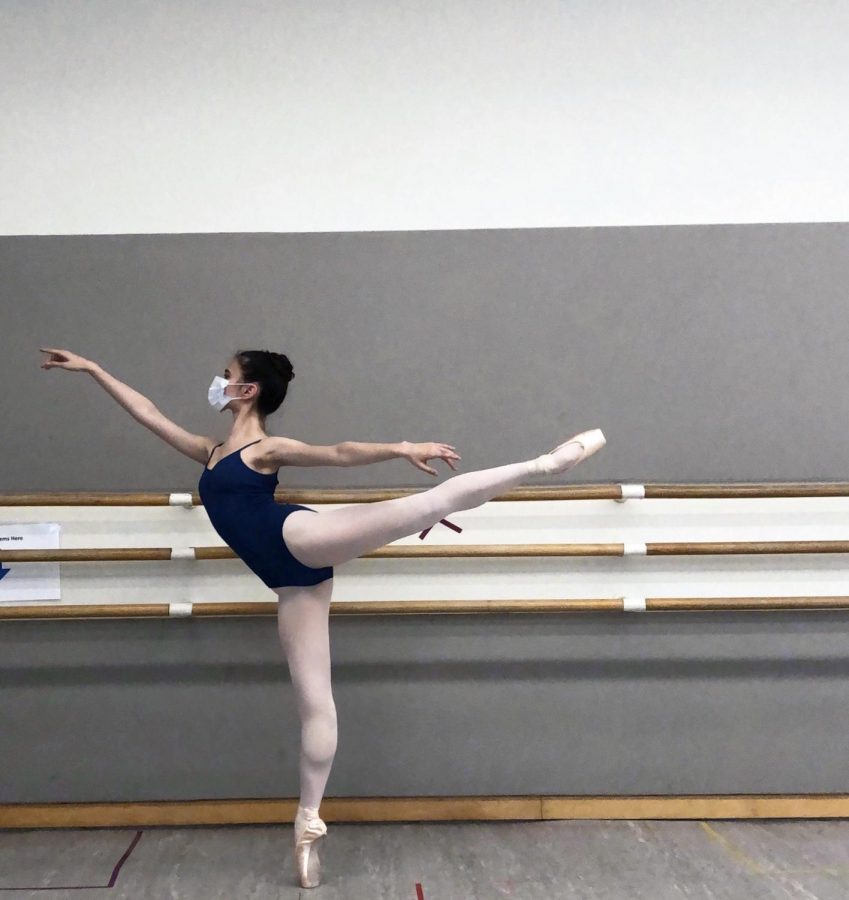Dancing through uncertainty
Dance companies adjust to survive during pandemic, aspiring professionals get a glimpse of instability in a dancers career
Kyla Marcus
Junior Lily Peta balances in arabesque in a San Francisco Ballet School studio. SF Ballet studios were opened to company members, school levels seven, eight and trainee in October after being closed since March.
February 21, 2021
After months of dancing in her living room, San Francisco Ballet School student Lily Peta returned to the studio in October. Much of the scene was familiar to Peta with the exception of the scent of sanitizer and rubbing alcohol seeping into the fabric of her mask as she sat, warming up, 6 feet away from the others in the studio.
“One of the happiest days I can remember was when we went back into the studio,” Peta said. “The energy of learning and working alongside real people is irreplaceable in an online environment.”
Although the SF Ballet studios had been open to in-studio dancing since October, it closed again on Jan. 20 after a member of the community tested positive for the coronavirus. Company members, school levels seven, eight and trainee returned to the studios a week later when medical professionals ruled the test was a false positive.
Lauren Pschirrer was dancing her fourth season with San Francisco’s Smuin Contemporary Ballet, about to perform a work by Osnel Delgado, an internationally renowned Cuban choreographer and director of Malpaso Dance Company, when stay-at-home-orders were put in place last March.
“We found out that we were going into shelter in place and I was devastated because Osnel Delgado had just come to San Francisco from being on tour with his company,” Pschirrer said. “I was gutted, devastated, shocked.”
As performing arts companies and schools closed their studios to dancers and audiences, living rooms became theaters and studios. Dancers used marley, a roll out vinyl dance floor, and portable barres and equipment to recreate a dance space.
“I moved a slice of marley, a wooden barre and a body size mirror into my living room,” sophomore Maya Lewis said. “It does the job, but is nothing like being in a real studio.”
While many dancers like Lewis are still anticipating a safe return to a studio, Smuin has begun using a pod system to bring a greater level of safety to dancers and choreographers. The 14 dancers in the company are divided into three groups that rotate between dancing at home and in the studio. Each pod has two designated choreographers that work within the group, according to Pschirrer.
The shift in who can safely work together has impacted how Smuin composed its digital fall and winter seasons repertoire. Performing arts companies like SF Ballet and Smuin have been releasing pre-recorded, digital performances online during their spring, fall and winter seasons, which has allowed a wider range of viewers to see their pieces. The performances have been an inspiration for aspiring dancers, according to Peta.
“Smuin has reached a broader audience by the virtual performances,” Pschirrer said. “I think Smuin will be different in the fact that there might be a whole virtual aspect to the future seasons in some way.”
Sharing company updates on social media and posting performances online has helped companies reach audiences and raise funds as well as make the companies themselves more accessible to the public.
“It is ironic because when live performances are shut down, they become more accessible through social media and online,” Peta said.
Performing for a camera instead of an audience can change how dancers approach choreography, giving them the luxury of a retake to make the performance as perfect as possible, but it eliminates spontaneity that comes from performing live, according to Pschirrer.
The upside ends there. Smuin downsized by two dancers from the 16-person company before the end of last year’s season.
“I want the audience to know that the arts are very much still alive — we just need the support from our fanbase to keep us going,” Pschirrer said. “If you want to continue to see Smuin, please keep supporting us because it motivates us to try and continue to do new and different things.”
The arts are bringing a light into a time many people are finding as dark, according to Lewis, and they need the community’s support to remain viable.
“It is nerve wracking for me to be making so many sacrifices for a career that has such an uncertain nature,” Peta, who plans on pursuing a career in dance said. “I find comfort in the fact that the dance industry is collectively experiencing all this upheaval, even though it is scary for me.”










